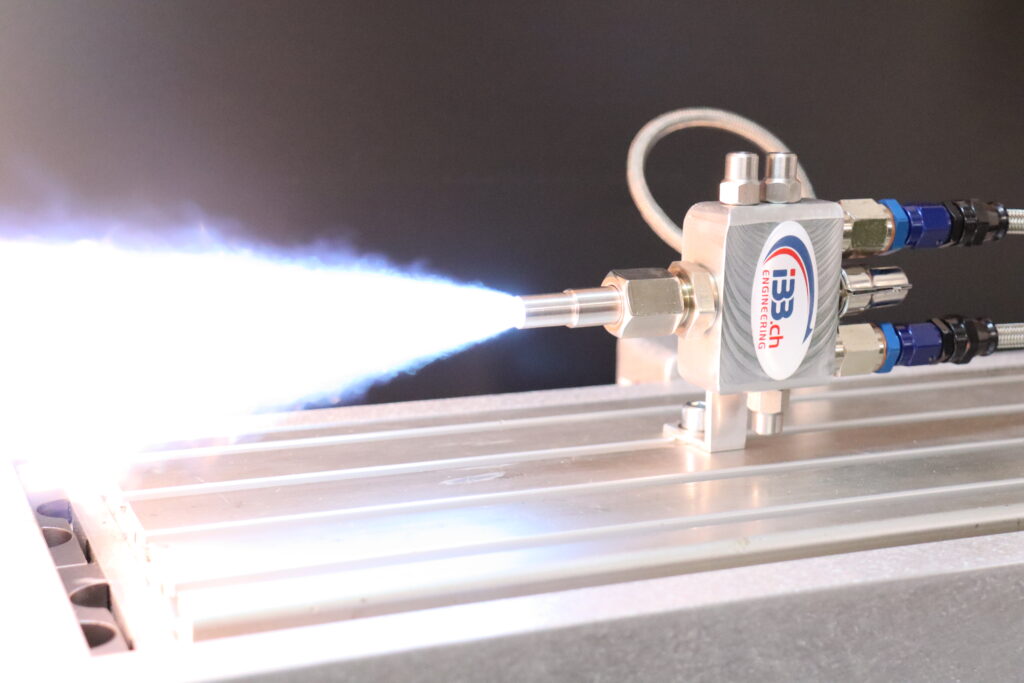Torch Igniters (IGNIS Torch Igniter Series)
Rocket engines, but also jet engines have to be ignited. This is usually done by a torch igniter, pyro igniter or with a hypergolic slug like Triethylborane/triethylaluminium (TEA-TEB). For a reliable ignition of a rocket engine you need enough energy delivered by the igniter (depending on the size of the main engine can be 1% of the thermal power of the main engine and so you end up wit ha small rocket engine by itself just for the torch igniter. We have a diverse palette of igniters suitable for test applications but also for flight configurations.
Our torch igniters run on GOX (gaseous Oxygen)/N2O (Nitrous Oxide) as the oxidizers and H2/Ethane/Propene/Propane on the fuel side with inlet pressure up to 30 bar or more. Igniters with other specifications can be developed on request (E.g. one or both components are liquid like Kerosene, Ethanol) or liquid N2O.
As a legacy from the time at SPL we also have some pyrotechnical igniters in our inventory which are usually used to ignite solid rocket motors, but you can ignite bi liquid rocket engines or hybrid with them as well. One of the pyro igniters uses reloadable cartridges for re-usability. We have a igniter related section in our library.
We herewith introduce the IGNIS product family of igniters. IGNIS is the Latin word for fire/heat (that’s what our igniters will produce 😉 )
Please keep in mind, that our products are normally in-house prototypes or developments for customers and are not COTS (commercial off-the-shelf) products.
Unfortunately we cannot accept any orders at the moment as we are involved in a development program that requires our full attention
Torch Igniter with adjustable Mass Flow
This torch igniter uses the concept of an internal bypass to cool the blast tube and keep the combustion close to the spark plug rel. cool. A good example of this design is described in a NASA paper you can also find in our library

A simplified version made of CuCrZr (HOVADUR) developed for a customer without internal bypass and surface spark plug to increase thermal robustness. The picture shows a run with N2O and Ethane at 10 bar input pressure.

The simplified version mentioned above, but now with an adapter with a blast tube and cooling bypass. The customer realized that the blast tube would still be a good idea 😉

The igniter together with the high voltage box running on 8-32 V / 1 A

Dimensions. Subject for changes depending on the customers need..
Download as a PDF
Features
- Adjustable mass flow (Oxidizer, Fuel, bypass blast tube)
- Oxidizer: Gaseous O2, gaseous N2O
- Fuel: H2, Propane, Ethane, other gaseous hydrocarbons
- Spark plug: CM6 or any other M10x1 Spark plug (preferable surface spark plugs)
- Integrated check valves
- Pressure: up to 30 bar
- Port for pressure sensor/switch (For ignition detection)
- Optional temperature sensor (Thermocouple type K)
One of our torch igniters got mentioned by everyday astronaut (one of the mayor channels about space related news) during an interview with SpaceX‘s Elon Musk. We never got asked about a permission, but hey, that’s still good advertising since the igniter carries our logo 🙂
The video just starts before we got mentioned. But the whole post is very worth to watch.
Our original movie from our YouTube Channel where the clipping comes from.
Other Torch Igniters (Mainly SPL heritage)
During our time at the Swiss Propulsion Laboratory SPL we developed several torch igniters to light our 2.5 kN and 10 kN engines. Just to document that time and the work we have done we mention that here as well.

This one runs on H2/O2. It was used on all liquid engines developed at SPL (2.5kn and 10 kN for example). Material: CuCrZr (HOVADUR)
Pyrotechnical Igniters (IGNIS Pyro Igniter Series)
Rocket engines, but also jet engines have to be ignited. This is usually done by a torch igniter, pyro igniter or with a hypergolic slug like Triethylborane/triethylaluminium (TEA-TEB). For a reliable ignition of a rocket engine you need enough energy delivered by the igniter (depending on the size of the main engine can be 1% of the thermal power of the main engine and so you end up wit ha small rocket motor by itself just for the igniter. We have a diverse palette of igniters suitable for test applications but also for flight configurations.
As a legacy from the time at SPL we have some pyrotechnical igniters in our inventory which are usually used to ignite solid rocket motors, but you can ignite bi liquid rocket engines or hybrid with them as well. One of the pyro igniters uses reloadable cartridges for re-usability. We have an igniter related section in our library.
Please keep in mind, that our products are normally in-house prototypes or developments for customers and are not COTS (commercial off-the-shelf) products.
yxcysx
This torch igniter uses the concept of an internal bypass to cool the blast tube and keep the combustion close to the spark plug rel. cool. A good example of this design is described in a NASA paper you can also find in our library





